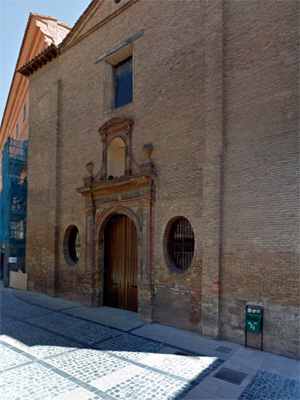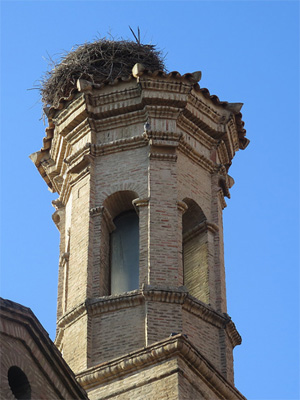| |
 |
 |
 |
| Comment on this report, or find other reports. |
 |
| Our Mystery Worshippers are volunteers who warm church pews for us around the world. If you'd like to become a Mystery Worshipper, start here. |
 |
| Find out how to reproduce this report in your church magazine or website. |
|
|
| 3132: Nuestra Señora de la Merced (Our Lady of Mercy), Tarazona, Spain |
 |
 |
 |
Mystery
Worshipper: Augustine the Aleut.
The church:
Nuestra Señora de la Merced (Our Lady of Mercy), Tarazona, Spain.
Denomination: Roman Catholic, Diocese of Tarazona.
The building:
Built at the end of the 15th century by Mercederian friars to replace the church of Santa Cruz del Rebate, destroyed in the war of the Dos Pedros, it still features the 1545 altarpiece by Jerónimo Cósida. However, the Mercederians wanted more space and in 1639 expanded the place to its current brick and ashlar form. The church features the usual long nave of Spanish churches of the period, with perhaps a dozen now-unused side altars. The largest altarpiece statue, of polychrome wood, was made by the Mercederian sculptor Fray Pedro Puey between 1734-37 and features the image of Our Lady of Mercy, the congregation’s patron. The Mercederians’ eighth centenary is coming up in 2018, for those interested.
Saint Peter Nelasco, founder of the order, gets one of the side altars, as do Saints Cosmas and Damian for the local guild of doctors, and the Virgin of the Snows for weavers. The octagonal tower has just been restored and sports a stork's nest, traditionally held as facilitating greater fertility for women passing by.
The church:
Secularized at the despoliation of the monasteries under Mendizábal in 1835, the former convent went through several municipal incarnations but is now the seat of the Conservatorio Estatal de Música (State Conservatory of Music) and is dedicated to Raquel Meller, an actress and singer born in the neighbourhood in 1888. This little church appears to have become the Conservatory’s chapel. The church is currently part of the parish of San Andrés, attached to the cathedral.
The neighbourhood:
A prosperous city during Roman times, Tarazona (called Turiaso by the Romans) suffered a decline after the fall of Rome and became Muslim in the 8th century. Muslims, Christians and Jews lived in harmony until the expulsion of the Moors. The city's narrow lanes are lined with medieval buildings in a mix of Gothic, Moorish and Renaissance styles. The church is just a few blocks from the río Quiles, in an area where most buildings are from the 17th or 18th century. The neighbourhood is mixed in the manner of another century, with poor folk and students in the garrets, the respectable types on the first floor, and shops on the ground floor. It’s not the trendiest part of town, but gentrification is underway, with boutique hotels and some good if not too trendy restaurants. The streets are too narrow for regular vehicle access and are blocked by mechanized barriers operated by electronic devices in residents’ cars.
The cast: There was no notice or announcement, and there is no parish website. The priest appeared to be elderly, possibly about 80.
The date & time:
24 September 2016, 8.00pm.
What was the name of the service?
Parish Mass.
How full was the building?
They could likely squeeze in 200. There were 35 present, of a wide range of ages, and almost as many men as women. People were generally respectably dressed, although perhaps a few had just come in from labouring jobs.
Did anyone welcome you personally?
I received curious but not inhospitable looks from parishioners, who could see that I was an outsider. Three or four, including an older woman in a now-rare mantilla, nodded at me. Another parishioner greeted me on the shoulder as he entered and passed by my pew.
Was your pew comfortable?
It was a little narrow, but the pews had been spaced decently from each other, so I was not cramped. I was seated near a statue of Our Lady of Sorrow in homage to my sorrowful 26km walk from the Sanctuary of Mercy outside Borja.
How would you describe the pre-service
atmosphere?
The church was quiet and cool, far from the heat of the day – 32°C that afternoon! This was the longest dry season that this region had seen in over 30 years.
What were the exact opening words of the
service?
The evening mass in the teeny church on the square was made extraordinary by the presence in the gallery of almost two dozen music students forming the choir, with a professional organist. The elderly priest came in, not to the usual silence, but with an entrada thundering out for the three dozen of us in the pews, followed by the usual invocation of the three persons of the Trinity: En el nombre del Padre, y del Hijo, y del Espíritu Santo.
What books did the congregation use during the
service?
They followed the service by memory.
What musical instruments were played?
There was a powerful Baroque organ in the gallery and somehow I think that some string instruments were being played. Was there a viola da gamba? I wish I knew more about Spanish Baroque music – I could not recognize any of the pieces played.
Did anything distract
you?
Not particularly. I was too exhausted by my long walk that day – 6km to the Sanctuary of Mercy near Borja with its peculiar, and a further 25km through the windmills and parched fields.
Was the worship stiff-upper-lip,
happy clappy, or what?
Everyone seemed quite relaxed, perhaps joining me in enjoying being out of the heat. And, as noted, we had an impressive choir of students in the gallery to shock us out of any lassitude.
Exactly how long was the sermon?
10 minutes.
On a scale of 1-10, how
good was the preacher?
8 – The priest's tone was friendly and relaxed, and there was no patronizing in his approach.
In a nutshell, what was
the sermon about?
I haven’t a clue. While I cannot blame the preacher, whose Aragonese accent was clear, I was really too tired from the day to catch more than a few sentences.
Which part of the service was like being in
heaven?
Oh heavens! The voices of the singers; the friendliness of parishioners to a foreigner in their midst.
And which part was like being in... er... the other place?
My inability to understand a word – I could barely follow the Lord’s Prayer, only recognizing it partway through. The gospel was from Luke, but then I got lost. But perhaps I was just really, really tired.
What happened when you hung around after the service looking lost?
After the mass, I went to the sacristy to get my pilgrim’s credencial stamped. The priest told me he had been ill for years and this parish was given to him as perhaps the only church he could run at his age. He said he was happy working with the conservatory students and could think of no better fate. They were serious and full of life and they were a gift to him.
How would you describe the after-service
coffee?
No after-service coffee, but at my hotel across the square, I enjoyed a plate of Aragonese broad beans followed by a plate of grilled quail, washed down with wine from the vineyard through which I had walked the day before. I fell into conversation with a neighbouring table where a father and daughter were travelling with his 85-year old grandmother. She spoke of how hungry she had been as a little girl during the civil war, and complimented me on my good sense of getting used to beans and quail, which (she said) could always be had when countries fell apart.
How would you feel about making this church your regular (where 10 = ecstatic, 0 = terminal)?
9 – Between the quiet friendliness of parishioners and the extraordinary music – in this world of amplification we forget the volume of the human voice – this would easily be my neighbourhood church should Providence or its little sister kismet somehow land me in Tarazona.

Did the service make you feel glad to be a
Christian?
Yes. The quiet friendliness of parishioners to this stranger among them, coupled with the astonishing music, took me on a time machine.
What one thing will you remember about all this in seven days' time?
Sitting in a church built for an order dedicated to freeing captives and slaves so many centuries ago, with powerful music from four centuries later, and surrounded by a cavalcade of exuberant and focussed and purposeful young artists.
More Camino reports |
|
|
 |
 |
 |
| We rely on voluntary donations to stay online. If you're a regular visitor to Ship of Fools, please consider supporting us. |
 |
 |
 |
| The Mystery Pilgrim |
 |
| One of our most seasoned reporters makes the Camino pilgrimage to Santiago de Compostela in Spain. Read here. |
 |
 |
 |
| London churches |
 |
| Read reports from 70 London churches, visited by a small army of Mystery Worshippers on one single Sunday. Read here. |
| |
|
|
|
|


